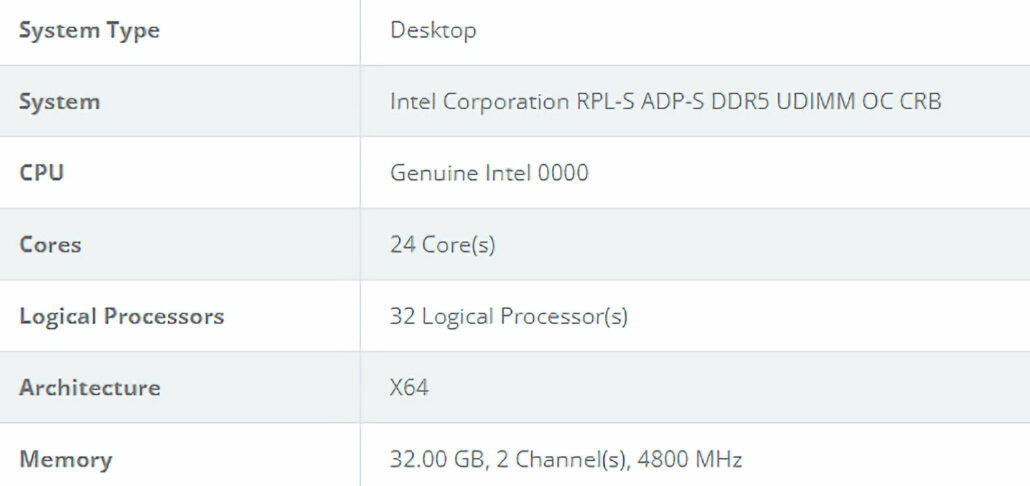
There is still at least a year to go before its official presentation takes place, but thanks to a leak we already know some Interesting details of the Intel Core i9-13900K, a processor that is set to become the chip giant’s next top of the line for the general consumer market, and which will be based on the Raptor Cove architecture, an evolution of Golden Cove that promises improvements in efficiency (performance per watt consumed ) and in IPC.
We still cannot specify, exactly, what improvement we can expect from the Intel Core i9-13900K in terms of IPC compared to the Intel Core i9-12900K, but seeing the pace that Intel has been following with its latest releases it is likely that it manages to increase the CPI between 10% and 19% compared to Golden Cove. Keep in mind that we are talking about high-performance cores, and not high-efficiency cores.
The high-efficiency cores should be based on the Gracemont architecture, the same we have seen in the Alder Lake-S series, although there is the possibility that Intel will introduce minor improvements. Regarding its core configuration, in the Intel Core i9-13900K we will have a block with 8 high-performance cores, based on the aforementioned Raptor Lake-S architecture, and another high-efficiency 16-core block based on Gracemont architecture
In total, the Intel Core i9-13900K will add 24 cores and will be able to work with a total of 32 threads, as high-performance cores will feature the technology HyperThreading which, as we know, allows them to parallelize two threads per core. High efficiency cores will be limited to one thread per core. It is a very curious configuration, without a doubt, although at the moment we do not know the working frequencies of this chip. All in all, we imagine that you should have no problem exceeding 5 GHz in turbo mode.
Intel Core i9-13900K: Why double the high-efficiency cores?
I’m sure this is the question you are all asking yourself, and the truth is that the answer is not complicated at all: because it is the most efficient way to scale multithreaded performance both by consumption and by space in the package. If Intel keeps the design, at the silicon level, that we saw with Alder Lake-S, Those 16 cores will take up roughly the same footprint as four high-performance cores, and they will have a much lower consumption.
For its part, the high-performance 8-core block of the Intel Core i9-13900K, which as we have said will be capable of handling up to 16 threads, will offer a notable jump at the IPC level, and will give the best of themselves. in applications where single-wire performance is paramount, like games for example. The 16 high-efficiency cores will be the back-up of the high-performance cores for those scenarios in which the demand for threads increases, as is currently the case with the Intel Core i9-12900K.
It is also important to keep in mind that with this hybrid design of high-efficiency and high-performance cores, Intel has been able to increase the maximum number of cores and threads of its processors without giving up a monolithic core configuration. By this I mean that all the elements of the Intel Core i9-13900K will be integrated into the same silicon tablet, and that you will not have to resort to the multi-chip module design that AMD has used in its Ryzen.
If all goes according to plan, the Intel Core i9-13900K, and the entire Raptor Lake-S series, will use the LGA1700 socketThey will be built on Intel Node 7 (10nm) and will come equipped with integrated GPUs based on Intel’s Xe architecture. Before closing, I want to share with you an estimate of the possible specifications that the next generation of high-performance processors from the chip giant will have.
- Intel Core i9 Gen13 K series: 8 P cores (performance) and 16 E cores (efficiency): 24 cores and 32 threads, 36 MB cache.
- Intel Core i7 Gen13 K series: 8 P cores (performance) and 8 E cores (efficiency): 16 cores and 24 threads, 30 MB cache.
- Intel Core i5 Gen13 K series: 6 P cores (performance) and 8 E cores (efficiency): 14 cores and 20 threads, 24 MB cache.
- Intel Core i5 Gen13 S series: 6 P cores (performance) and 4 E cores (efficiency): 10 cores and 16 threads, 21 MB cache.
- Intel Core i3 Gen13 S series: 4 P cores (performance) and 0 E cores (efficiency): 4 cores and 8 threads, 12 MB cache.
- Intel Pentium Gen13 S series: 2 cores P (performance) and 0 cores E (efficiency): 2 cores and 4 threads, 6 MB cache.




